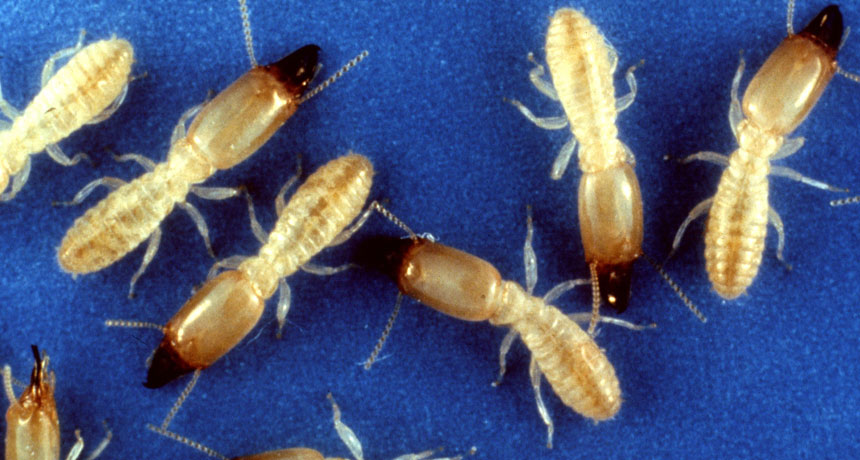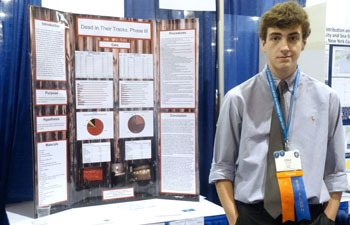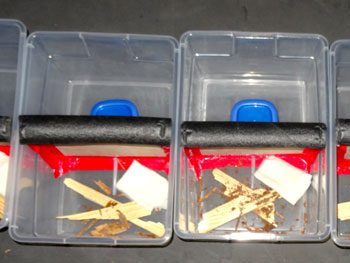Ink leads way to terminating termites
The tiny insects follow an inked trail to their doom

These termites use chemical trails to lead their friends to food. A teen used that as a way to lead them to their end.
Giancarlodessi/Wikimedia Commons
Share this:
- Share via email (Opens in new window) Email
- Click to share on Facebook (Opens in new window) Facebook
- Click to share on X (Opens in new window) X
- Click to share on Pinterest (Opens in new window) Pinterest
- Click to share on Reddit (Opens in new window) Reddit
- Share to Google Classroom (Opens in new window) Google Classroom
- Click to print (Opens in new window) Print
PHOENIX, Ariz. — It started out as a simple classroom experiment involving a few termites, some ballpoint pens and a paper plate. Inspired by the demonstration, a teen has invented a new method to more effectively lure termites to their doom.
Cole Balkman, 18, showed off his new termite terminator in May at the Intel International Science & Engineering Fair. The annual competition, created by Society for Science & the Public and sponsored by Intel, brings together students from around the world. This year, more than 1,700 students from 75 countries presented their research. (The Society also publishes Science News for Students.)

Termites are insects that live in huge colonies. They eat wood — making them a big problem when they take up residence in homes. When termites find a woody meal, they will lay down a trail for their colony-mates to follow. The trail is made of pheromones (FAIR-uh-moanz) — chemicals that change the behavior of fellow termites. In this case, those pheromones told the other termites: “Follow me to where the food is.”
Why do termites follow ink? It turns out that some pens contain a chemical called 2-phenoxyethanol (Feh-NOX-ee-ETH-an-ol). It helps the ink dry quickly. But this chemical also mimics an ingredient in the termites’ trail pheromone. Fooled by the smell, a termite will follow the penned line.
When it came time to design a science fair project, Cole remembered the termite demonstration. At first, he just ran termites through mazes, trying to see if different insecticides would keep them away from certain paths. The next year, remembering the termite’s pen-following ways, the teen decided to investigate “some kind of baiting scheme.”
Perhaps, he thought, a pen’s ink might lure termites to an insecticide. Then, if one termite followed the inked trail to the poison, it could bring back some of that toxic chemical to share with others in the nest. Once it died, its fellow termites would eat their fallen comrade — getting more of the insecticide in the process.
To design a device, Cole needed a lot of termites. So he purchased 1,500 from a company that sells science supplies. He stored the bugs in 20 large plastic tubs. In the beginning, it “was quite a battle with my mother,” he notes. Not very many people want termites living in their houses.

In 10 of the tubs, the tubing and the cup with the insecticide were left alone. But in the rest, the teen coated the inside of the plastic tubing with the ink from a ballpoint pen. Hehe had run that ink through a centrifuge. This machine spins materials very quickly. The more dense chemicals will settle at the bottom, leaving less dense ones at the top. The section with the termite’s trail mimic was in the middle. Cole took this section and smeared it on 10 of his set ups, and presented all 20 to colonies of termites. He left the cups and tubes in place for 72 hours, then came back to see how many termites were still alive.
Among termites exposed to the tubing and cup alone, only a bit more than one-fifth of the bugs died. But when the tubes were painted with concentrated pen ink, “the termites would investigate the tube” and be compelled to follow it to the bug killer, Cole reports. With the lure of that ink, the teen successfully killed off three-quarters of his termites.
Cole hopes that such a system might help people more effectively get rid of termites, and for less money. The whole setup costs less than $5, he says. Having an exterminator come to the house would be much more expensive. In addition, because the termites are lured to the poison, much less insecticide would be needed.
But someone else is going to have to develop that product, Cole says. Right now he’s headed to college at the University of Arkansas in Fayetteville. He plans to major in mechanical engineering. After three years of following this one trail, he says, he’s a little sick of termites.
Follow Eureka! Lab on Twitter
Power Words
(for more about Power Words, click here)
centrifuge A machine with an interior that rotates very quickly. This applies centripetal force to separate liquids. Denser chemicals settle at the bottom, leaving less dense compounds on the top.
centripetal force A force that acts on an object as it moves along a curved path. This force is directed into the center of the curve or circle. (Centripetal means “center seeking” in Latin.)
imidacloprid A chemical used to kill insects. Applied to crops or soil, it attacks an insect’s nervous system. Primary targets include aphids to termites. It can also harm non-targeted insects, such as bees.
insect A type of arthropod that as an adult will have six segmented legs and three body parts: a head, thorax and abdomen. There are hundreds of thousands of insects, which include bees, beetles, flies and moths.
insecticide An insect killer. Some kill all kinds of insects, while others are selective for specific types.
2-phenoxyethanol A chemical added to the ink in some pens to make it dry quickly. This chemical also mimics a termite’s trail pheromone — a type of chemical signal used tell other colony members where they can find food.
pheromone A molecule or specific mix of molecules that makes other members of the same species change their behavior or development. Pheromones drift through the air and send messages to other animals, saying such things as “danger” or “I’m looking for a mate.”
Society for Science and the Public (Society) A nonprofit organization created in 1921 and based in Washington, D.C. Since its founding, the Society has been not only promoting public engagement in scientific research but also the public understanding of science. It created and continues to run three renowned science competitions: The Regeneron Science Talent Search (begun in 1942), the Intel International Science and Engineering Fair (initially launched in 1950) and Broadcom MASTERS (created in 2010). The Society also publishes award-winning journalism: in Science News (launched in 1922) and Science News for Students (created in 2003). Those magazines also host a series of blogs (including Eureka! Lab).
termite An ant-like insect that lives in colonies, building nests underground, in trees or in human structures (like houses and apartment buildings). Most feed on wood.